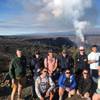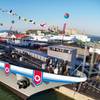SHI Develops RTLinux Powered Robots
In addition to the Spider robot, SHI has developed a RTLinux powered pipe alignment robot also in production use and a third, Stewart-Gough Type 6-axes parallel robot is under development. The robots use SHI designed 3-D path tracking and real-time attitude control systems. SHI Project Leader and Managing Director Jae-Hun Kim says “RTLinuxPro and the excellent support from RealTimeWave helped us bring this complex equipment from design to production in record time and with low development cost.” Young-Jun Park, the Principal Research engineer for SHI adds that “RTLinuxPro has a unique capability of combining very precise real-time with the standard Linux platform so that we could make the time sensitive control algorithms operate together with background processing without worrying about interference”. Jae-Hun Kim also notes that “SHI has interests in the ship automation and building automation system markets where we think there will be much future growth and RTLinux is a key technology for us in this area.” Victor Yodaiken, FSMLabs CEO said “Samsung is famous for shipbuilding technology, so their selection of RTLinux is a strong endorsement and one that cements RTLinux's reputation for enabling cutting edge production technology.”
FSMLabs RTLinuxPro and RTCoreBSD let developers meet requirements for low-latency hard-real-time responsiveness without sensitivity to application load for a wide range of CPU clock rates. Worst case interrupt latencies can vary from under 2 microseconds on a AMD Opteron to 20microseconds on a 100Mhz Arm9. These measurements are all computed while the Linux or BSD “guest” operating system is fully loaded and the network is being stressed. By comparison, native Linux and BSD limit real-time performance, with response times for comparable operations measured in terms of milliseconds, not microseconds. The host/guest architecture enables developers of intelligent devices to build high-reliability systems and to support the ever-increasing software content on those devices. Application developers can take advantage of the RTLinux and RTCoreBSD models to use standard Linux and BSD applications and services in conjunction with POSIX 1003.13 real-time code that runs in the RTCore environment. Source: FSMLabs, Inc.













